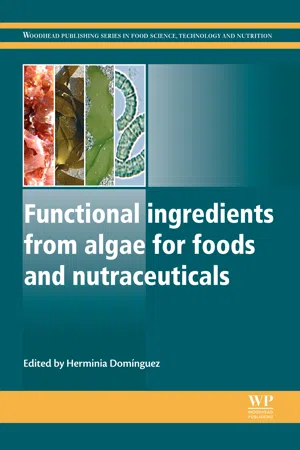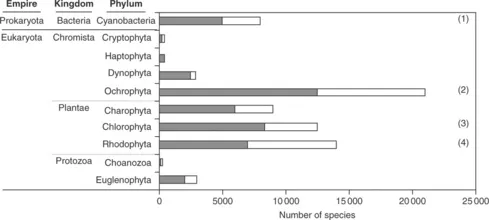Abstract:
An overview on the potential of algae as a source of active ingredients useful for the formulation of functional foods and nutraceuticals is presented. The importance of knowing the major causes of biochemical and biological variability to adequately valorize this resource and to obtain a product with homogeneous characteristics is discussed. General aspects of functional foods and nutraceuticals are introduced, including emerging research trends, product development, market opportunities and consumer preferences. The major challenges in relation to the characterization of the raw materials, confirmation of healthy properties, development of products and technologies are suggested.
1.1 Introduction
Substantial research efforts are being devoted to the identification and characterization of functional food ingredients that might help prevent chronic disease or optimize health, a trend supported by growing consumer demand. The marine ecosystem has the potential to supply high added value ingredients that exhibit multiple activities, and algae are promising organisms for providing both essential compounds for human nutrition and novel bioactive substances with medicinal and pharmaceutical value (Smit, 2004), suited for developing functional foods (Holdt and Kraan, 2011).
Worldwide availability, abundance, diversity and productivity make algae an important source of biologically active metabolites of natural origin. The complex algal composition and the presence of valuable chemical fractions support the rational and integral utilization of algae as a primary biomass feedstock, in the same way as terrestrial biomass from forest or agricultural origin. The possibility of obtaining a range of products from algal biomass involving environmentally friendly technologies conforms to a sustainable approach fitting into the concept of biorefinery. Knowledge of composition, functionality and bioactivity is essential for the future development of multi-step, multi-purpose processes to enable rational exploitation of algae.
This chapter presents a general overview of the concepts used in the book, particularly in relation to the raw material, sustainable processing technologies and the requirements of the active ingredients for the development of functional foods and nutraceuticals.
1.2 Algae
A concise presentation of the aspects pointing out the relevance of algal taxonomy, their diversity and variability and their industrial and commercial importance are offered in this section to illustrate the interest and potential of alga.
1.2.1 Definition and classification
The term ‘algae’ refers to a large variety of polyphyletic, mostly photosynthetic organisms, which have different origins, evolutionary lines and biochemistry. Algae are presently referred to in four kingdoms: Bacteria, Plantae, Chromista and Protozoa, and occur in dissimilar forms and sizes, from unicellular or colonial microalgae to multicellular marine organisms (macrophytes, seaweeds). Microalgae, the most primitive and simple members of plant kingdom, are found in benthic and littoral waters. Microalgae have been traditionally classified according to cytological and morphological aspects and to the type of reserve metabolites, constituents of the cell wall and pigments. Marine diatoms exhibit a golden-brown colour because of xanthophyll fucoxanthin, whereas the blue-green algae contain chlorophyll a and related compounds. Macroalgae are traditionally classified according to chemical and morphological characteristics, with special relevance to the presence of specific pigments, which determine the inherence to one of the three algal divisions: brown, red and green algae (van den Hoek et al., 1995; Barsanti and Gualteri, 2006). Brown (Phaeophyceae) is the largest type of algae, the brown or yellow-brown colour is due to fucoxanthin; red algae (Rhodophyceae) often have brilliant colour due to phycoerythrin and phycocyanin, which are dominant over the other pigments, chlorophyll a, β-carotene and a number of xanthophylls; green algae (Chlorophyceae) contain chlorophyll a and b in the same proportion as in higher plants.
A historical and complete classification is found in the text by Sambamurty (2005). The traditional classification of algae is still useful to define the level of organization although algal taxonomy is being re-examined and revised. Electron microscopy and molecular biology, which have resulted in a much more precise circumscription of the different groups of algae, are tools having a great impact on the taxonomical classification of algae (Barsanti and Gualteri, 2006). Modern evidence about the evolutionary relationships between the main algal taxa (Stengel et al., 2011) and those algae that are potential sources of bioactives, and for which important algal taxonomic rearrangements were produced (Rindi et al., 2012) have recently been reviewed. The total number of algae, according to AlgaeBase (2012), was conservatively estimated to be about 72 500, of which more than 20 000 will be diatoms; approximately 40% of the estimated algae are yet to be described. The estimated number of identified and non-identified algae is shown in Fig. 1.1 for individual phyla and classes (Guiry, 2012). Some examples of the classes and genera which are more widely studied for their reported bioactivities are also indicated.
Fig. 1.1 Total estimated number of species of algae in the major phylum (with more than 100 species), (
) described and (
) not described (
Guiry, 2012), and some examples of taxa with actual commercial value (
Stengel et al., 2011).
1.2.2 Algal diversity and variability
Algal bioactive compounds of commercial interest include pigments, lipids and polyunsaturated fatty acids, proteins, polysaccharides and phenolics, and the biological activities reported for these components are varied (Derner et al., 2006; Plaza et al., 2008 and 2009). The full exploitation of algal diversity and complexity requires the knowledge of environmental impacts and the understanding of biochemical and biological variability to guarantee stable and high-quality products. Natural variability in the content of bioactive molecules should not be considered a hindrance to commercial utilization and has been related to (i) taxonomic or phylogenetic relationships, (ii) ecological adaptations and (iii) chemical diversity, significantly affected by natural variability (Stengel et al., 2011). Taxonomic distribution can depend on the presence of genes and on gene expression, often under environmental and ecological regulation. Ecological diversity of algae is evident since they colonize a range of habitats, from open oceans to rocky shores and freshwaters. The presence, form and level of bioactive compounds of natural algal populations are further influenced by (i) spatial and temporal environmental variability due to heterogeneity of physico-chemical parameters (light, nutrients, CO2 availability, temperature, salinity, pH, contaminants and biotic impacts), spatial and population differences based on environmental tolerances, temporal changes and reproductive development; (ii) variation within thalli, depending on function and position; (iii) responses to environmental parameters (light, nutritional history, salinity, temperature and contaminants); and (iv) biotic interactions (Stengel et al., 2011).
1.2.3 Actual and future commercial importance
Algae is a great biological resource with potential for use as a raw material, although only some of them have been studied from the point of view of their chemical composition, properties and production on a commercial scale (González-Delgado and Kafarov, 2011; Holdt and Kraan, 2011). Microalgae possess immense morphological and metabolic diversity, but considerably fewer natural products have been isolated from this group compared to macroalgae, since their biosynthetic potential is underestimated and many microalgal metabolites are yet to be discovered (Sasso et al., 2012). The great biodiversity and variability in the biochemical composition of the biomass obtained from the microalgal cultures, and the genetic and the technological improvement in massive production, have favoured their commercial cultivation for the production of high value added compounds. Economically competitive production needs further development of technical conditions (Varfolomeev and Wasserm...



